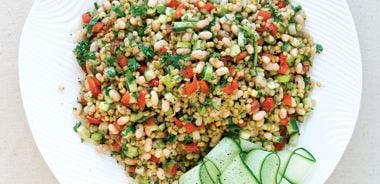Wheat Berry and Navy Bean Salad

Wheat berries are sold dry in most health food stores. The colourful and nutty berries are whole kernels of wheat that have been hulled but left with their bran and germ intact. They must be soaked overnight before cooking. When mixed with legumes, wheat berries make a complete meatless protein.
Salad1 cup (250 mL) dry wheat berries 2 cups (500 mL) canned white navy beans, drained 1 long English cucumber, diced 1 large red pepper, seeded and diced 4 green onions, chopped 1 large tomato, diced 2 cloves garlic, minced 1 cup fresh parsley, chopped Salt and pepper to taste
Dressing1/4 cup (60 mL) cold-pressed, extra-virgin olive oil 2 Tbsp (30 mL) balsamic vinegar 1 Tbsp (15 mL) tamari 2 Tbsp (30 mL) lemon juice 1 tsp (5 mL) hot mustard
In medium bowl soak wheat berries overnight in cold water. Drain wheat berries and place in saucepan; cover with 2 in (5 cm) cold water. Bring to boil; reduce heat to low and simmer, partially covered, about 1 hour. Drain and cool.
In large bowl, combine cooled wheat berries with beans, cucumber, red pepper, tomato, green onion, garlic, and parsley; season with salt and pepper to taste.
In small bowl make dressing by whisking together olive oil, vinegar, tamari, lemon juice, and hot mustard until well combined.
Toss salad with dressing just before serving. Serves 6.
Each serving contains: 400 calories; 20 g protein; 10 g total fat (1.4 g sat. fat, 0 g trans fat); 65 g carbohydrates; 16 g fibre; 23 mg sodium
source: "Give Grains a Chance", alive #321, July 2009




